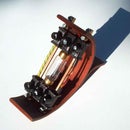Introduction: Steampunked Flickering Lightbox Driven by Battery
Hi everybody!
I created this "Steampunked flickering lightbox" as a sample for a steampunk workshop. The participants should build a basic version of a battery driven flickering light and then had been asked to create their own steampunk version of it. Now I want to present you my draft and I hope you enjoy it.
Before we start with this detailed description please have a look at this small movie:
And now let´s start!
Step 1: Basic Version for the Steampunk-workshop
First I want you to show the basic version and tell you a little bit about the preparation of this workshop. Then the detailed explanation of all additional parts will be shown in the following steps.
Well, some months ago I was asked if I could give a steampunk workshop at a maker faire in Germany.
I agreed and the preparations started.
Do you still remember this high voltage power supply instructable of mine?
After collecting all parts together I startetd to built my own version.
Step 2: A Detailed Look Inside
Luckily I got this very old and broken joint box made of black Bakelite. After some minutes of working with superglue and polishing the box could be used again The broken edges got some brass made cover nuts M8 for stability reasons. The missing parts of the sides had been filled with some red fibre plates decorates with brass screws as you can see. Only the fibre plate in front of this lamp got a new green LED as an indicator light and another fibre plate at the right side now holds the switch.
The indicator light (already part of the circuit) is necessary to warn you if the circuit inside is still running without the bulb or in case a broken bulb.
Step 3: Adding the Steampunk Elements: the Shade
The reflector shade had been cut out of som perforated copper plate. To get the rounblank a little more spherical I took an old soup ladle (don´t tell it to my wife!!) and a hammer. First I dished the copperplate into the ladle and later I worked out the convex surface at the same ladle;-))
Next I took some strong copper wire and soldered it as a frame around the shade. The ends of the wire lead into a sleeve nut and were fixed with epoxy resin. This nut also took the threaded rod to fix the shade with the joint box. At least I needed a small piece of copper tube as a spacer and to cover the rod.
Step 4: Adding the Steampunk Elements: the Special Multifunctional Screws
To keep the joint box closed and to fix later the copper wire coils I developed special screws with parts of old straight run globe valves as you can see. There is also another possibility to fix more decorating parts by using the top screw wit the small cover nut.

Participated in the
Trash to Treasure Contest 2017













